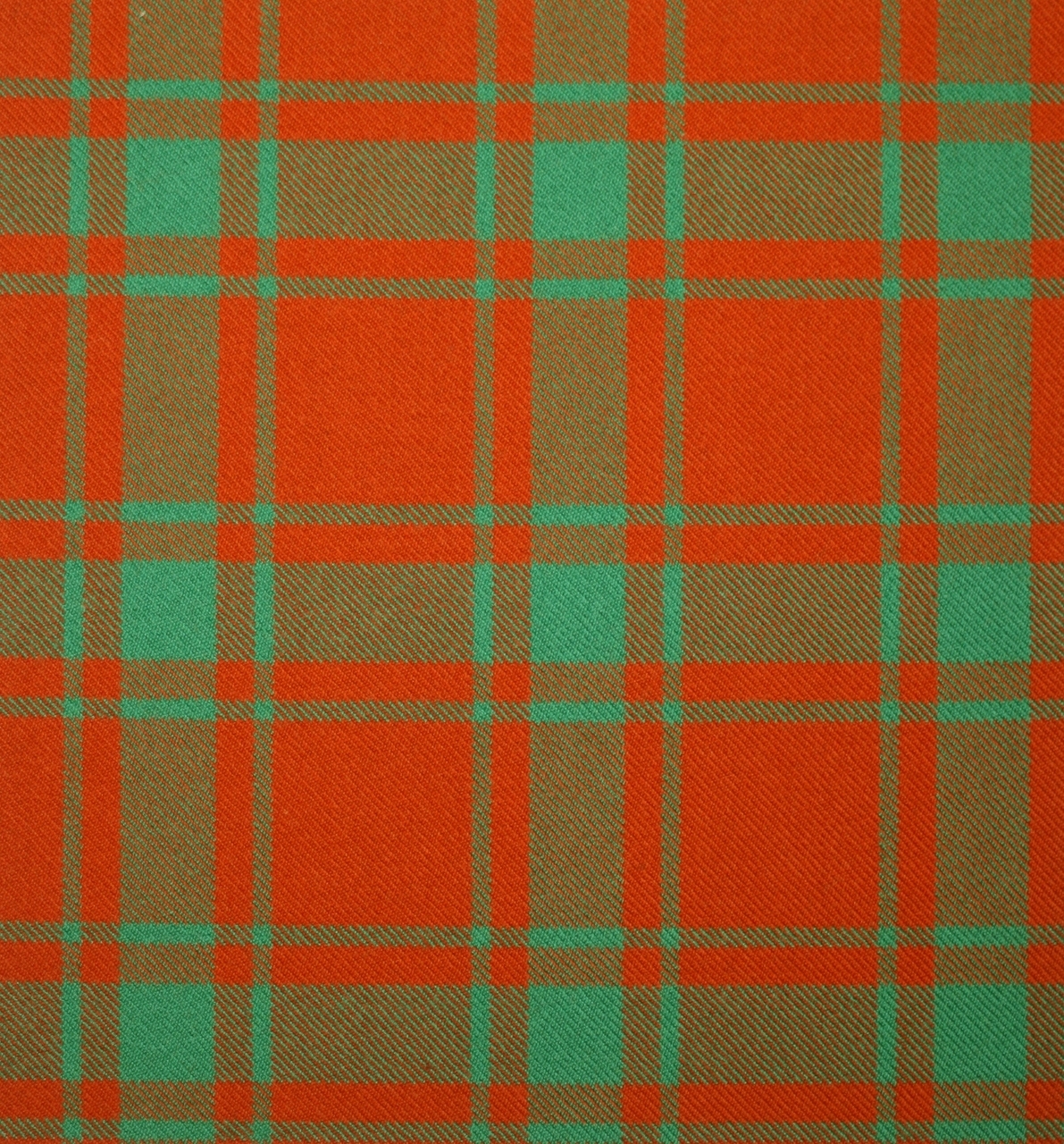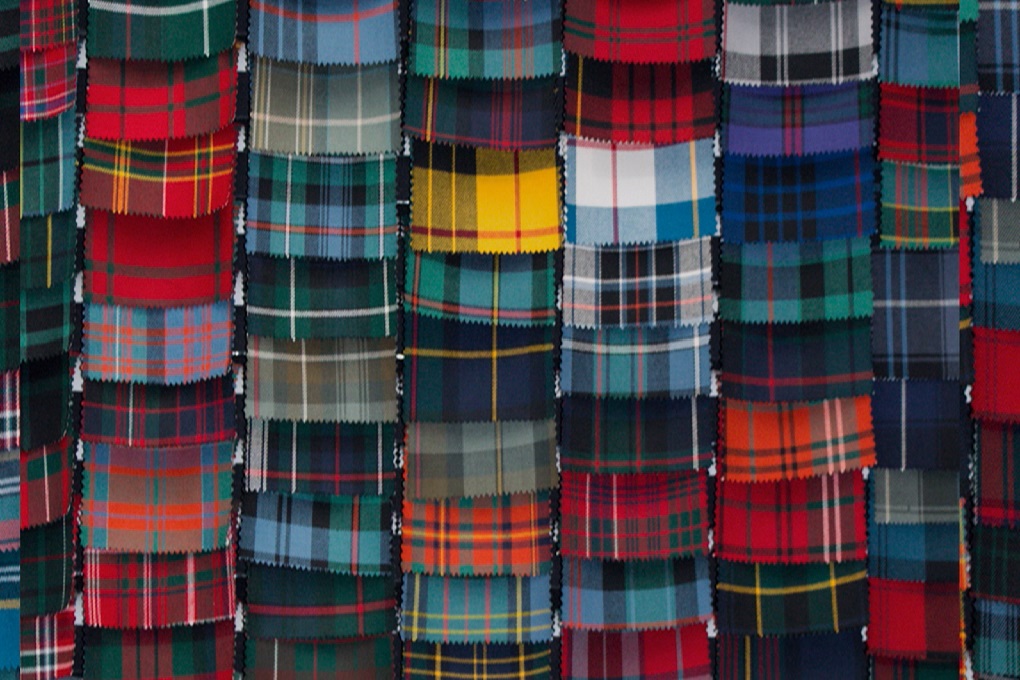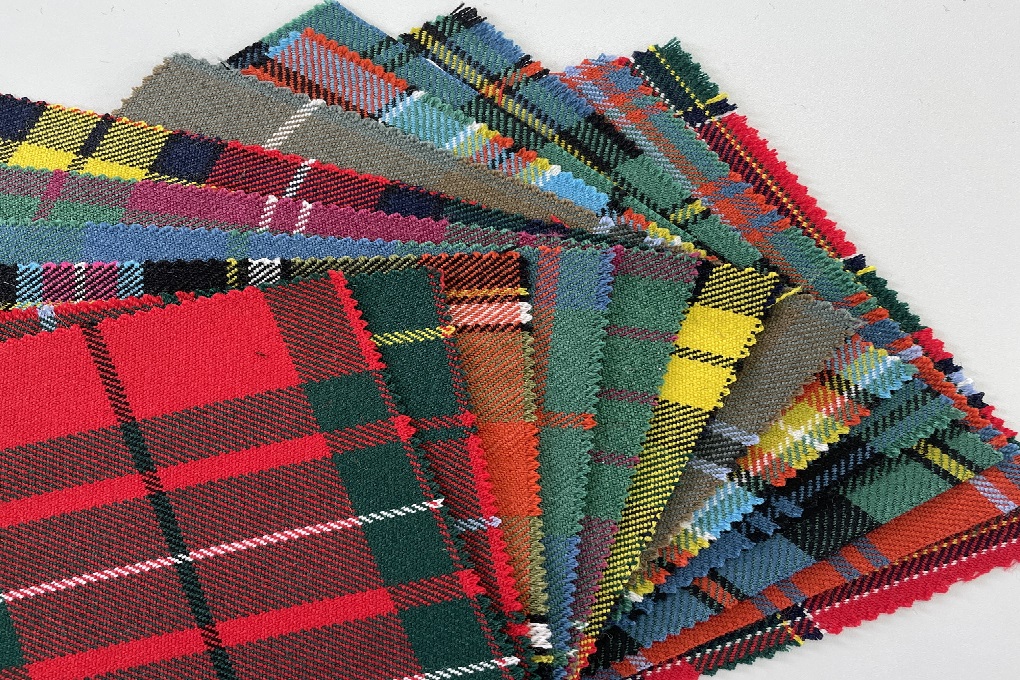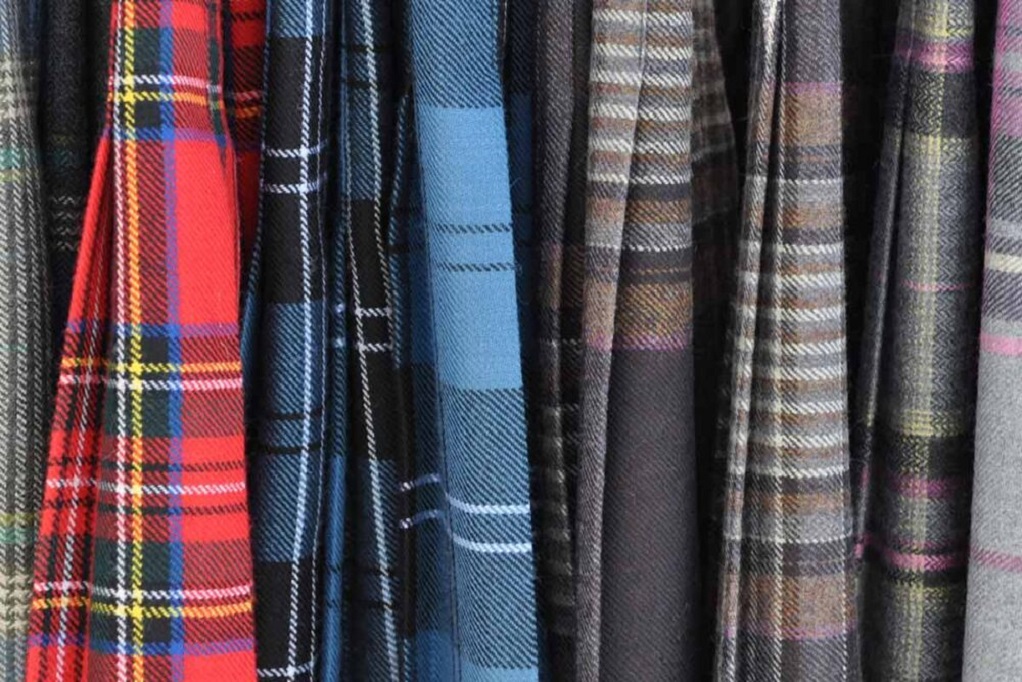Wee History of Scottish Tartan
Modernly, we use the word Tartan to describe cloth (usually wool) that uses threads of different colors in both the warp (vertical threads) and weft (horizontal threads) of the weave to create a distinct pattern, usually of several colors. The pattern can be varied by the colors, number of colors and number of threads used in each band of color. The “thread count” is how all Scottish tartans are recorded and cataloged.
You may be used to hearing this Scottish cloth called “plaid” but strictly speaking, that word refers to a layer of cloth used as a garment or covering. In Gaelic, “A Plaid” is a blanket. Hence the Highlanders wear a piece known as a Day Plaid that is essentially a picnic blanket thrown over the shoulder when not in use.
The original Gaelic word for tartan is Breacan which means “checkered”, “variegated” or “speckled”. Tartan seems to be a borrowed word. The most popular theory for the origin of our modern word is the Middle French word, Tiretaine, which referred to linsey-woolsey material. That is, a weave of linen (warp) and wool (weft). This is quite plausible given Scotland’s long history of friendship with France. However, some scholars believe it derives from the Irish word Tarsna (crosswise) or the Scots Gaelic Tarsuinn (across).
“Tartan” or “Plaid” as a creative color weaving technique may be found across the globe. You will find beautiful examples from India, China, and Japan, often woven from cotton or silk. For the “Celtic” version of the art of tartan, one of the earliest examples we have is from the Tarim Basin in western China. You may have heard of the famous Caucasoid mummies of Urumchi. Roughly three hundred miles east of Urumchi, near the modern town of Hami, is a site called Qizilchoqa (Red Hillock). In 1979, archaeologists found an ancient cemetery here which, like Urumchi, contained the remains of people with light brown or blond hair; thick beards on the men and long braids on the women. The cloth fragments on these mummies are fascinating as it shows a common origin with Indo-European Neolithic clothing. Textile expert Elizabeth Wayland Barber has noted its similarity with cloth fragments recovered from salt mines of the Hallstatt culture. But even more intriguing is the fact that its closest resemblance is to Scottish tartan of the 17th century or later! The feel of the wool, the twill, the number of color lines (up to six) as well as the varying thickness and thinness of color bands is strikingly familiar despite the age of the samples — around 2000 – 1000 BC!
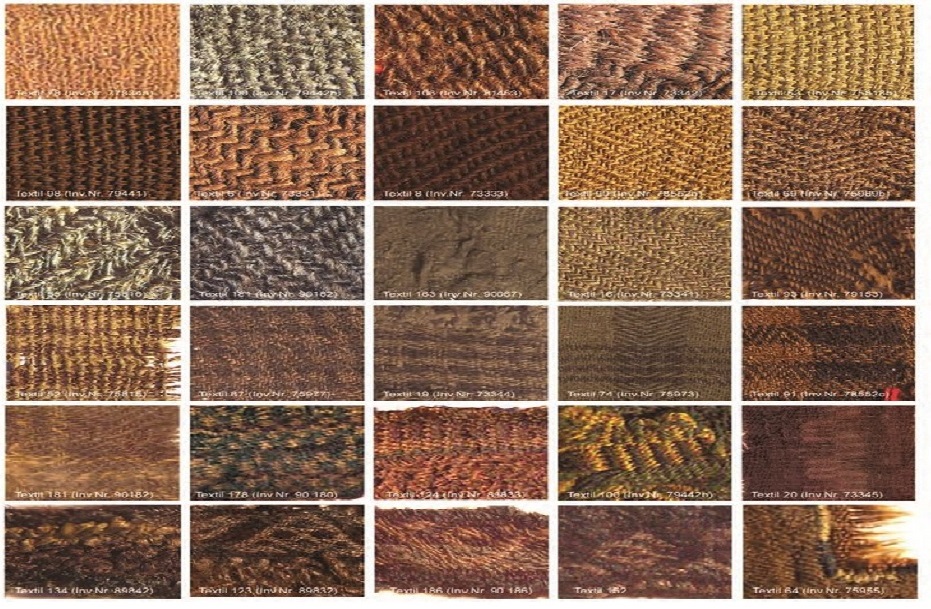
Jump forward now to the European Iron Age. From the 8th to the 5th century, BC, the proto-Celtic “Hallstatt culture” flourished. The name refers to the principal archaeological site of Hallstatt, a lakeside village in the Austrian Alps southeast of modern Salzburg (and is usually broken down into four distinct time periods and “zones”). This kingdom was highly advanced and part of the proto-Celtic culture complex which spread a common art style, religion, and language through trade across Europe (forerunners of the La Tène culture). One of the principal exports of Hallstatt was salt. The salt mines here have preserved a trove of wonderful artifacts including bits of cloth dropped by the ancient miners. Twill “Tartan” designs are numerous and a few have even been re-created. They are generally simpler than the ancient Qizilchoqa samples, but they seem to have set a standard of style which endured for centuries.
We know that the ancient Celts wore tartan cloth. Evidence suggests that the Celts often wore tartan cloaks and pants. These articles of clothing are often described as “striped” by Roman writers, who did not have a convenient word to describe plaid patterns. “The way the Celts dress is astonishing: they wear brightly colored and embroidered shirts, with trousers called bracae and cloaks fastened at the shoulder with a brooch, heavy in winter, light in summer. These cloaks are striped or checkered in design, with the separate checks close together and in various colors.” Diodorus Siculus, Greek Historian, 100BC
The oldest depiction of a tartan garment is on a bronze fragment from North Africa. It was part of a statue erected about 1800 years ago atop a triumphal arch in the ancient Moroccan city of Volubilis which is 1,500 miles from Scotland. The statue depicted the Roman Emperor Caracalla riding a chariot. He styled himself as “Conqueror of the Caledonians” (the catch-all Roman term for Celtic barbarians north of Hadrian’s Wall, mainly the Picts). The surviving statue piece is from the emperor’s cloak and shows the Tartan Trews (close-fitting pants) of a captive Caledonian warrior. The pattern was carved into the statue and inlaid with different alloys of bronze and silver to give a remarkable impression of the textile’s color and texture. The complete statue was destroyed centuries ago and only the three-foot-long fragment remains.
Celtic Cowgirl – “Here’s to it! The fighting sheen of it. The yellow, the green of it. The white, the blue of it. The swing, the hue of it. The dark, the red of it. Every thread of it! The fair have sighed for it. The brave have died for it. The foeman sought for it. Heroes fought for it. Honor the name of it. Drink to the fame of it – THE TARTAN!”
The next example we have is the famous “Falkirk Tartan”, now housed at the National Museum of Scotland. It is one of the earliest examples of Scottish cloth in existence. Dating back to the Roman occupation of the Antonine Wall area (around 250AD), the small piece of wool was found stuffed into a clay pot filled with over 2,000 silver Roman coins. It is ironic to think that, in the long term, the treasure someone once hoarded away turned out not to be the money, but the cloth used to pad it. The Falkirk tartan is an early Celtic tweed, just like many of the Hallstatt fragments. “Tweed”, by the way, is derived from the Scots word “tweel” which is “twill” and refers to a weave of “twos” meaning the threads are woven in groups of two to form ridges and patterns as well as greater durability and protection.
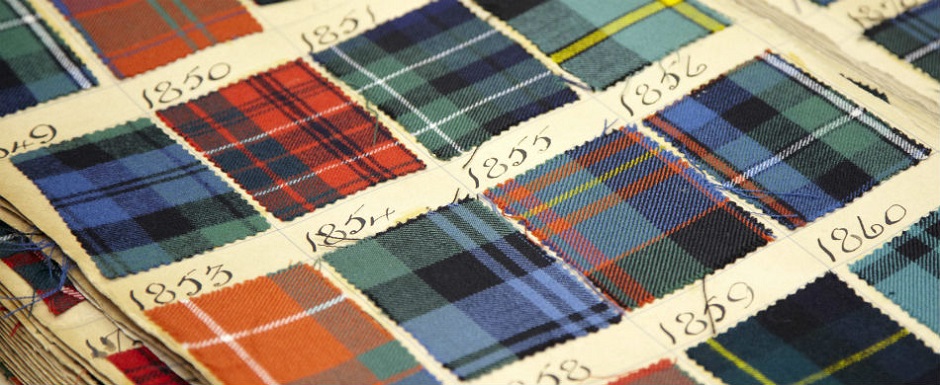
For the Falkirk cloth, undyed yarn from brown and white sheep was woven into a two-colored herringbone pattern. The check pattern of the tweed is sometimes referred to as a “poor man’s plaid’ theoretically because it avoids use of plant dyes, which historically have been time-consuming to process and perhaps more costly as a result. This may be myth, but the check has been associated very specifically with cattle drovers, and later, shepherds of the Border region who were encouraged to move north after the Highland clearances. Thus, a version of the ancient Falkirk check is now also known as the ‘Border’ or ‘Border Reiver’ tartan. It is woven as a family tartan for the surname ‘Shepherd’ and also as ‘Northumberland’ since the Duke of Northumberland designated it for his personal piper around 1760.
Ben Johnson – “The Reivers were the product of the constant English-Scottish wars that would often reduce the Border area to a wasteland. The continuing threat of renewed conflict offered little incentive to arable farming. Why bother planting crops if they may be burned before they could be harvested? The reiving (raiding or plundering) of livestock was however a totally different matter, and so it became the principal business of the Border families. The Reiver came from every social class from laborer to peer of the realm. He was a skilled horseman and fine guerrilla soldier, practiced in the fine arts of arson, kidnapping and extortion. There was no social stigma attached to reiving, it was simply an accepted way of life.”
After this, we wait about 1,000 years before glimpses of tartan start to appear as written mentions in legal documents. The earliest of these is a writing by T(h)urgot, Prior of Durham and Bishop of St. Andrews, who used the term Diversis coloribus vestes (“multi-colored clothing”) sometime around 1100. A bit later, we get unus caligarum braccatarum de tiretatana (“one pair of tartan trews”) noted in the expenses of John, Lord of the Isles in 1355.
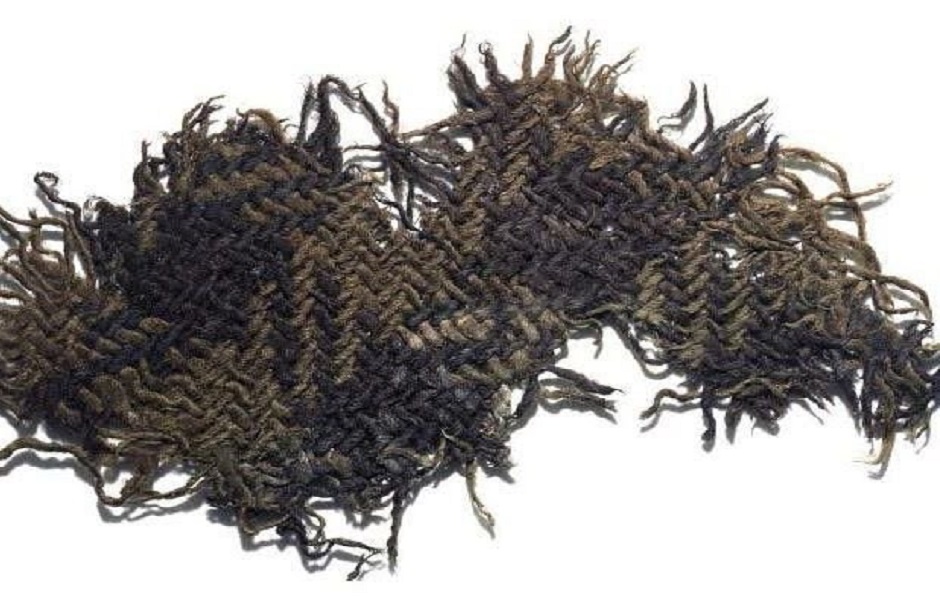
In 1471, John, Bishop of Glasgow, treasurer to James III, recorded: “Ane elne and ane halve of blue Tartane to lyne his gowne of cloth of gold… Four elne and ane halve of Tartane for a sparwort aboun his credill… Halve ane elne of doble Tartane to lyne ridin collars to her lade the Quene.” One ell was 37 inches.
This breadcrumb trail goes on and on with better and better documentation as the years pass; eventually ending with the business records of Wilsons of Bannockburn, and the other great tartan mills involved in the revival of tartan in the 18th and 19th centuries. Depictions in art are less common until the 17th century. Suffice to say, the art of the ancients clearly lived on and evolved into something glorious. As of 2018, The Scottish Register of Tartans, the official government body established in 2009, includes over 7,800 tartans in their database.
Article Credit: Ben Johnson – https://usakilts.com/blog/the-oldest-tartans.html
Photo Credit – Plaidplace.com
Photo Credit – Scotland Shop
Photo Credit – Cimmino
Photo Credit – The Journal – Alps & Meters
Photo Credit – USA Kilts
Photo Credit – The Scotsman

